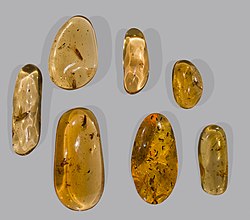
Back بوابة:علم الأحياء القديمة Arabic Portal:Paleontologia Catalan Portail:Paléontologie French Portale:Paleontologia Italian Portal:Paleontology Malay Portaal:Paleontologie Dutch Portal:Paleontologia Polish Portal:Paleontologia Portuguese Портал:Палеонтология Russian Портал:Палеонтология Tatar
|
The Palaeontology Portal
Introduction Paleontology (/ˌpeɪliɒnˈtɒlədʒi, ˌpæli-, -ən-/ PAY-lee-on-TOL-ə-jee, PAL-ee-, -ən-), also spelled palaeontology or palæontology, is the scientific study of life that existed prior to the start of the Holocene epoch (roughly 11,700 years before present). It includes the study of fossils to classify organisms and study their interactions with each other and their environments (their paleoecology). Paleontological observations have been documented as far back as the 5th century BC. The science became established in the 18th century as a result of Georges Cuvier's work on comparative anatomy, and developed rapidly in the 19th century. The term has been used since 1822 formed from Greek παλαιός ('palaios', "old, ancient"), ὄν ('on', (gen. 'ontos'), "being, creature"), and λόγος ('logos', "speech, thought, study"). Paleontology lies on the border between biology and geology, but it differs from archaeology in that it excludes the study of anatomically modern humans. It now uses techniques drawn from a wide range of sciences, including biochemistry, mathematics, and engineering. Use of all these techniques has enabled paleontologists to discover much of the evolutionary history of life, almost back to when Earth became capable of supporting life, nearly 4 billion years ago. As knowledge has increased, paleontology has developed specialised sub-divisions, some of which focus on different types of fossil organisms while others study ecology and environmental history, such as ancient climates. (Full article...) Selected article on the prehistoric world and its legaciesDiscovered in 1822 and described three years later by English geologist Gideon Mantell, Iguanodon was the second dinosaur formally named, after Megalosaurus. Together with Megalosaurus and Hylaeosaurus, it was one of the three genera originally used to define Dinosauria. A large, bulky herbivore, Iguanodon is a member of Iguanodontia, along with the duck-billed hadrosaurs. The taxonomy of this genus continues to be a topic of study as new species are named or long-standing ones reassigned to other genera. Scientific understanding of Iguanodon has evolved over time as new information has been obtained from the fossils. The numerous specimens of this genus, including nearly complete skeletons from two well-known bonebeds, have allowed researchers to make informed hypotheses regarding many aspects of the living animal, including feeding, movement, and social behaviour. As one of the first scientifically well-known dinosaurs, Iguanodon has occupied a small but notable place in the public's perception of dinosaurs, its artistic representation changing significantly in response to new interpretations of its remains. (see more...) Did you know?

General images -The following are images from various paleontology-related articles on Wikipedia.
Selected article on paleontology in human science, culture and economics
The history of paleontology traces the history of the effort to study the fossil record left behind by ancient life forms. Although fossils had been studied by scholars since ancient times, the nature of fossils and their relationship to life in the past became better understood during the 17th and 18th centuries. At the end of the 18th century the work of Georges Cuvier ended a long running debate about the reality of extinction and led to the emergence of paleontology as a scientific discipline.
The first half of the 19th century saw paleontological activity become increasingly well organized. This contributed to a rapid increase in knowledge about the history of life on Earth, and progress towards definition of the geologic time scale. As knowledge of life's history continued to improve, it became increasingly obvious that there had been some kind of successive order to the development of life. After Charles Darwin published Origin of Species in 1859, much of the focus of paleontology shifted to understanding evolutionary paths. The last half of the 19th century saw a tremendous expansion in paleontological activity, especially in North America. The trend continued in the 20th century with additional regions of the Earth being opened to systematic fossil collection, as demonstrated by a series of important discoveries in China near the end of the 20th century. There was also a renewed interest in the Cambrian explosion that saw the development of the body plans of most animal phyla. (see more...) On this day...
Selected image
CategoriesTopicsGeneral - Paleontology - Fossil - Evolution - Extinction Quality ContentFeatured paleontology articles
- Achelousaurus
- Acrocanthosaurus
- Albertosaurus
- Allosaurus
- Amargasaurus
- Ankylosaurus
- Apatosaurus
- Archaeopteryx
- Baryonyx
- Carnotaurus
- Catopsbaatar
- Ceratosaurus
- Chicxulub Crater
- Compsognathus
- Cretaceous–Tertiary extinction event
- Daspletosaurus
- Deinocheirus
- Deinonychus
- Deinosuchus
- Dilophosaurus
- Dinosaur
- Diplodocus
- Dromaeosauroides
- Edmontosaurus
- Elasmosaurus
- Giganotosaurus
- Gorgosaurus
- Herrerasaurus
- Iguanodon
- Istiodactylus
- Lambeosaurus
- List of dinosaur genera
- Majungasaurus
- Massospondylus
- Megalodon
- Nemegtomaia
- Nigersaurus
- Opisthocoelicaudia
- Paranthodon
- Parasaurolophus
- Plateosaurus
- Psittacosaurus
- Seorsumuscardinus
- Spinosaurus
- Stegosaurus
- Stegoceras
- Styracosaurus
- Tarbosaurus
- Thescelosaurus
- Triceratops
- Tyrannosaurus
- Velociraptor
Things you can doCurrent Paleontology FACs - None yet... WikiProjectsRelated portalsAssociated WikimediaThe following Wikimedia Foundation sister projects provide more on this subject:
Discover Wikipedia using portals |
© MMXXIII Rich X Search. We shall prevail. All rights reserved. Rich X Search







































